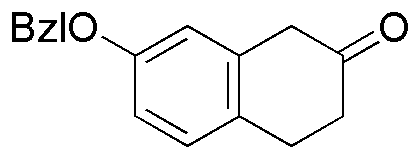7-Benzyloxy-3,4-dihydro-1H-naphthalen-2-one is widely utilized in research focused on:
- Pharmaceutical Development: This compound serves as a valuable intermediate in the synthesis of various pharmaceuticals, particularly those targeting neurological disorders, due to its ability to modulate neurotransmitter activity.
- Organic Synthesis: It is often used in organic chemistry as a building block for creating complex molecules, enabling researchers to explore new chemical pathways and develop innovative materials.
- Biochemical Research: The compound's unique structure allows it to be studied in biochemical assays, helping scientists understand enzyme interactions and metabolic pathways.
- Material Science: Its properties make it suitable for developing advanced materials, including polymers and coatings, which can enhance durability and performance in various applications.
- Agricultural Chemistry: This chemical has potential applications in agrochemicals, particularly in the formulation of pesticides or herbicides that require specific biological activity to improve crop protection.
General Information
Properties
Safety and Regulations
Applications
7-Benzyloxy-3,4-dihydro-1H-naphthalen-2-one is widely utilized in research focused on:
- Pharmaceutical Development: This compound serves as a valuable intermediate in the synthesis of various pharmaceuticals, particularly those targeting neurological disorders, due to its ability to modulate neurotransmitter activity.
- Organic Synthesis: It is often used in organic chemistry as a building block for creating complex molecules, enabling researchers to explore new chemical pathways and develop innovative materials.
- Biochemical Research: The compound's unique structure allows it to be studied in biochemical assays, helping scientists understand enzyme interactions and metabolic pathways.
- Material Science: Its properties make it suitable for developing advanced materials, including polymers and coatings, which can enhance durability and performance in various applications.
- Agricultural Chemistry: This chemical has potential applications in agrochemicals, particularly in the formulation of pesticides or herbicides that require specific biological activity to improve crop protection.
Documents
Safety Data Sheets (SDS)
The SDS provides comprehensive safety information on handling, storage, and disposal of the product.
Product Specification (PS)
The PS provides a comprehensive breakdown of the product’s properties, including chemical composition, physical state, purity, and storage requirements. It also details acceptable quality ranges and the product's intended applications.
Certificates of Analysis (COA)
Search for Certificates of Analysis (COA) by entering the products Lot Number. Lot and Batch Numbers can be found on a product’s label following the words ‘Lot’ or ‘Batch’.
*Catalog Number
*Lot Number
Certificates Of Origin (COO)
This COO confirms the country where the product was manufactured, and also details the materials and components used in it and whether it is derived from natural, synthetic, or other specific sources. This certificate may be required for customs, trade, and regulatory compliance.
*Catalog Number
*Lot Number
Safety Data Sheets (SDS)
The SDS provides comprehensive safety information on handling, storage, and disposal of the product.
DownloadProduct Specification (PS)
The PS provides a comprehensive breakdown of the product’s properties, including chemical composition, physical state, purity, and storage requirements. It also details acceptable quality ranges and the product's intended applications.
DownloadCertificates of Analysis (COA)
Search for Certificates of Analysis (COA) by entering the products Lot Number. Lot and Batch Numbers can be found on a product’s label following the words ‘Lot’ or ‘Batch’.
*Catalog Number
*Lot Number
Certificates Of Origin (COO)
This COO confirms the country where the product was manufactured, and also details the materials and components used in it and whether it is derived from natural, synthetic, or other specific sources. This certificate may be required for customs, trade, and regulatory compliance.

